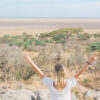Why Do Climbers Summit Kilimanjaro at Night?
Summiting Kilimanjaro, the highest mountain in Africa, is a dream for many adventure enthusiasts. However, reaching the summit is a challenging task that requires physical and mental endurance. One of the unique features of climbing Kilimanjaro is that climbers start their ascent to the summit in the middle of the night.

The question is, why do climbers summit Kilimanjaro at night? There are several reason for it, continue reading to find out.
Better Chance Of Clear Weather
Climbing Kilimanjaro can be a challenging and unpredictable experience, with weather conditions changing rapidly and unexpectedly. Even though the mountain is located near the equator, it is tall enough to create its own weather patterns. This means that it is subject to a variety of weather, including high winds, heavy rain, and snow. Most of the time this occurs during the afternoon and dies down once the sun sets. To increase the chances of reaching the summit in clear weather, you’ll begin the final ascent around 11 PM, when the weather is typically more stable and predictable.
Better Acclimatization

Acclimatization is the process by which the body adapts to higher altitudes and lower levels of oxygen. Climbing Kilimanjaro can be particularly challenging because the altitude gain is quite rapid, and the air pressure and oxygen levels decrease as you climb higher. By starting the final ascent at night, climbers have the advantage of being able to gradually acclimatize to the higher altitude over several hours, rather than making a rapid ascent during the day.
Avoiding Sun Exposure

Another advantage of climbing Kilimanjaro at night is that it allows climbers to avoid prolonged exposure to the sun, which can be particularly intense at high altitudes. The UV radiation at high altitude is much stronger than at lower elevations, and the sun’s rays can cause sunburn, dehydration, and other health problems. Climbing at night, allows climbers to minimize their exposure to the sun’s harmful rays and reduce their risk of sunburn and other health problems.
More Time To Rest

Climbing Kilimanjaro is a physically demanding activity that requires a lot of energy and stamina. The final ascent to the summit can take anywhere from 6 to 10 hours, depending on the route and the pace of the climbers. By starting the ascent at night, climbers have the advantage of being able to rest during the day, when the temperatures are higher and the sun is shining. This allows them to conserve their energy and be better prepared for the final push to the summit.
Spectacular Sunrise Views

One of the most breathtaking experiences of climbing Kilimanjaro is watching the sunrise from the summit. The view from the top of the mountain is truly awe-inspiring. You’ll be amazed by the panoramic views of the surrounding landscape and the sun rising over the horizon. By starting the final ascent at night, climbers have the advantage of reaching the summit in time to watch the sunrise, which is one of the most memorable moments of the entire climb.
Long Day
The day you head to the summit is the most grueling day. You’ll be hiking for up to 14 hours. Starting at night and finishing during the day is better mentally. Finishing your hike after a long of hiking can potentially have a mentally negative effect.
Success Rates

Finally, climbing Kilimanjaro at night has been shown to increase summit success rates. According to some studies, climbers who start their final ascent in the early hours of the morning are more likely to reach the summit than those who start later in the day. This is because climbers who start early have a better chance of encountering clear weather, avoiding sun exposure, and being well-rested and acclimatized for the final push to the summit.
Final Thoughts
Climbing Kilimanjaro at night offers several advantages, including better chances of clear weather, better acclimatization, avoiding sun exposure, more time to rest, spectacular sunrise views, and higher summit success rates. While climbing at night can be challenging and require extra preparation and planning, it is a unique and rewarding experience that many climbers find to be the highlight of their trek.













